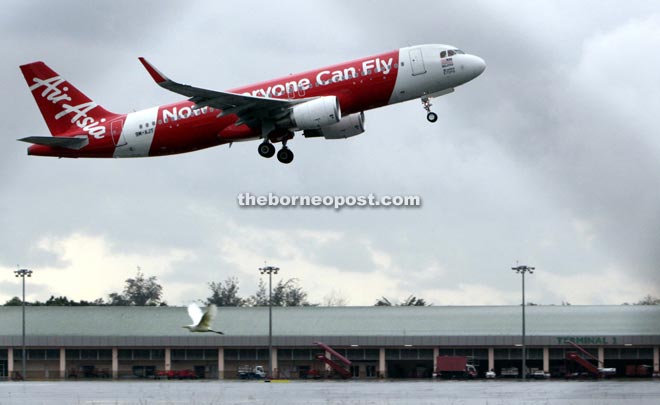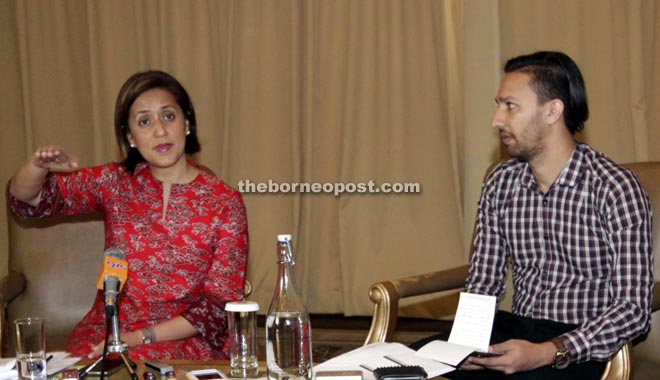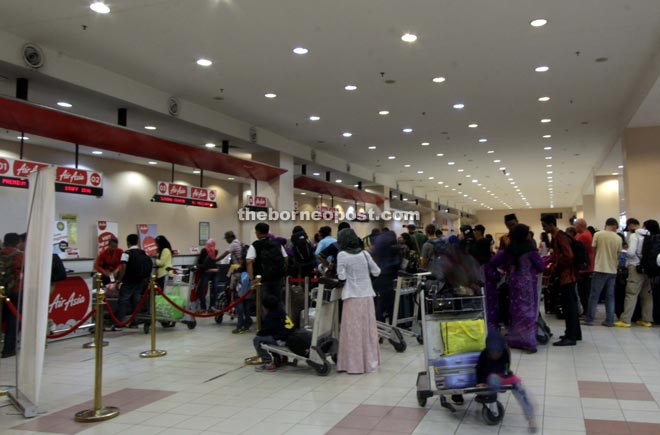
An AirAsia aircraft taking off from KKIA Terminal 2.

Aireen (left) explains how moving to KKIA Terminal 1 will affect AirAsia’s long-term plans for Kota Kinabalu and Sabah as a whole.

Moving to Terminal 1 will mean increased passenger service charge (PSC) and will affect passenger traffic.
KOTA KINABALU: AirAsia Berhad chief executive officer Aireen Omar yesterday ended months-long speculations on the airline’s supposed move to Kota Kinabalu International Airport (KKIA) Terminal 1, and announced that they are staying put at Terminal 2.
“We’ve made a firm decision that we are not moving to Terminal 1, and we have made the necessary appeal to the Minister of Transport who is currently looking into this,” she said yesterday in a press briefing here.
Aireen cited various limitations as reasons for the decision, including more than a hundred per cent increment in passenger service charge (PSC) should the move materialise.
“The passenger service charge (PSC) will be a lot higher at Terminal 1 than it is at Terminal 2. Over at Terminal 2, when we fly internationally, passengers pay PSC of RM32. But then if we move to Terminal 1, PSC will be RM65 per passenger – which is more than a hundred per cent increment. And I don’t think that’s right for passengers to pay extra just to move to another terminal.
“It will impact the industry as it will impact the demand for travel. Our passengers are more price sensitive. Hence with this increase, passengers will think twice about flying. They will probably think several times whether they want to bring their spouses, or whole families, or not, or they won’t fly frequently. It will impact the international connectivity plans that we hope to build in Sabah,” she said.
Malaysia Airports Berhad (MAB) had asked AirAsia to move its operations from KKIA Terminal 2 in Tanjung Aru to the main KKIA Terminal, by August 1, the latest deadline given to the low cost carrier since the last deadline in January.
AirAsia’s biggest concern, said Aireen, was how the move would impact the company’s long-term plans for the state which are steered in the direction to make Kota Kinabalu the next key international hub in the region after Kuala Lumpur.
She said there were limitations in terms of resources and infrastructures available at Terminal 1 that did not facilitate the operations of low cost carriers well.
“Moving to Terminal 1 means that we have to share facilities with other airlines. And after a few years, we know that once we put more aircraft at Terminal 1, we will exceed the capacity of the terminal. So where do we go from there? There are limitations in terms of the capacity in which we can grow,” she said.
There are currently six AirAsia aircraft based in its Kota Kinabalu terminal, with the exception of two units which the company has been wanting to bring in since 2012, but was reportedly refused by MAB due to the instruction to move to Terminal 1.
Aireen said the low-cost carrier company had five to ten-year plans to bring in at least 20 aircraft to be based in Kota Kinabalu, which would not be possible if AirAsia was to make the move to Terminal 1.
She described MAB’s call to move AirAsia to Terminal 1 as merely a short-term plan without proper long-term plans in terms of maintenance and growth.
“They want us to move, because they want to address their short-term problem at Terminal 1. But that’s not a good business decision. It’s not good for long-term development for Sabah, tourism and the aviation industry in general.
“We are running a business; you can’t ask us to be short term in our outlook to just move to Terminal 1 and then after that, what happens? Because our plans run from five years to ten years. Whereas for them, it’s move first and figure it out later.
“It is very important to have the right infrastructure to facilitate the growth that we envision for Sabah. But instead, it’s more of asking us to fit into their short-term plan as opposed to fitting what’s the overall bigger plan that our airline can do to the local economy and to the state of Sabah.
“What kind of expansion plans does MAB have for us? Because right now they said it was not in their growth plans or master plan to have a low-cost carrier terminal. Their primary concern is just to move us into Terminal 1 in the short term, and basically as you can see, the design of Terminal 1 doesn’t facilitate our low-cost operations.”
She explained that AirAsia has had various discussions with MAB, whom they have repeatedly voiced their concerns as well as their growth plans. Despite this, MAB has insisted on its instructions for the company to move.
“The thing is, we have been having this ongoing discussion for many years. We have been very diplomatic and we have explained where we stand and we have gone to various authorities to also explain to them our stand,” she said.
This, said Aireen, was not fair, especially considering that AirAsia had given the biggest contribution to the growth of passenger traffic and tourism into Sabah.
“Last year itself, more than 50 per cent of the passenger volume came from AirAsia. And we have explained to them about our expansion plans. How can you just disregard that?
“We know our potential. We know how to stimulate the market and how to generate passenger traffic. We’re not sure whether MAB understands that because they asked us to move into a facility that doesn’t allow us to operate and grow in the manner that we hope to.”
AirAsia’s Terminal 2 in Tanjung Aru has also been under constant criticism for its bad facilities, which Aireen said had been forwarded to MAB numerous times, but was ignored due to possible pressure to move to Terminal 1. The low-cost carrier had also received pressures from local tourism organisations to agree to make the move to Terminal 1, as passengers generally prefer a centralised airport.
However, taking into consideration AirAsia’s recent bouts with MAB regarding various issues at Kuala Lumpur International Airport (KLIA) 2, Aireen said the company did not wish to see the same thing happen if they move to Terminal 1.
“We don’t want to repeat what we have experienced at KLIA 2. You move there, the whole design doesn’t facilitate low-cost carriers concept, and we end up struggling 90 per cent of the time.
“For now we are still doing our best to provide the best kind of service and convenience in the limited conditions of Terminal 2. Still, we can’t move (to Terminal 1) when things are not in order. If we move to Terminal 1 now, the cost of operations will increase by at least another RM4 million per annum.”
Aireen suggested to possibly privatise Terminal 2, albeit with approval from the government or agreement to work together with AirAsia for such plans.
“There are suggestions to privatise Terminal 2 and work together with the state government to turn it into a big low-cost carrier terminal. We are willing to work together with the state government if they’re open to that.
“But whatever it is, as long as there are firm plans to facilitate a permanent low-cost terminal, yes, we will consider moving to Terminal 1. But they will need to discuss with us on this, because we don’t want a repeat of what we’re facing at KLIA 2 where they built something that just completely doesn’t facilitate the operations in a way that we would like it to be.
“MAB needs to be more interactive and communicate more with us as opposed to having that monopoly way of conducting their business. The frustration is there because there are so many issues that we want to address. Like in the case of KLIA 2, there are many issues and they are very slow in attending to them,” said Aireen.
